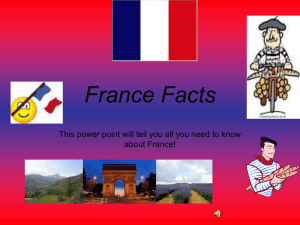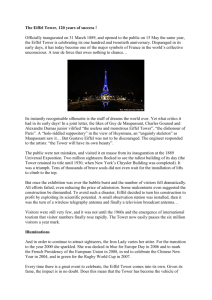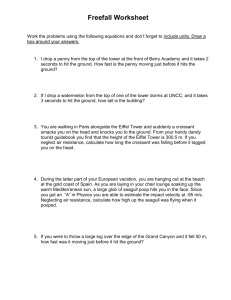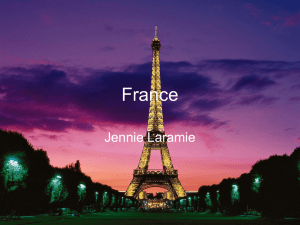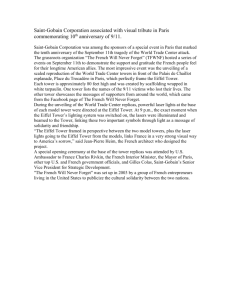Sadlier Test Prep Level B Unit 2
advertisement
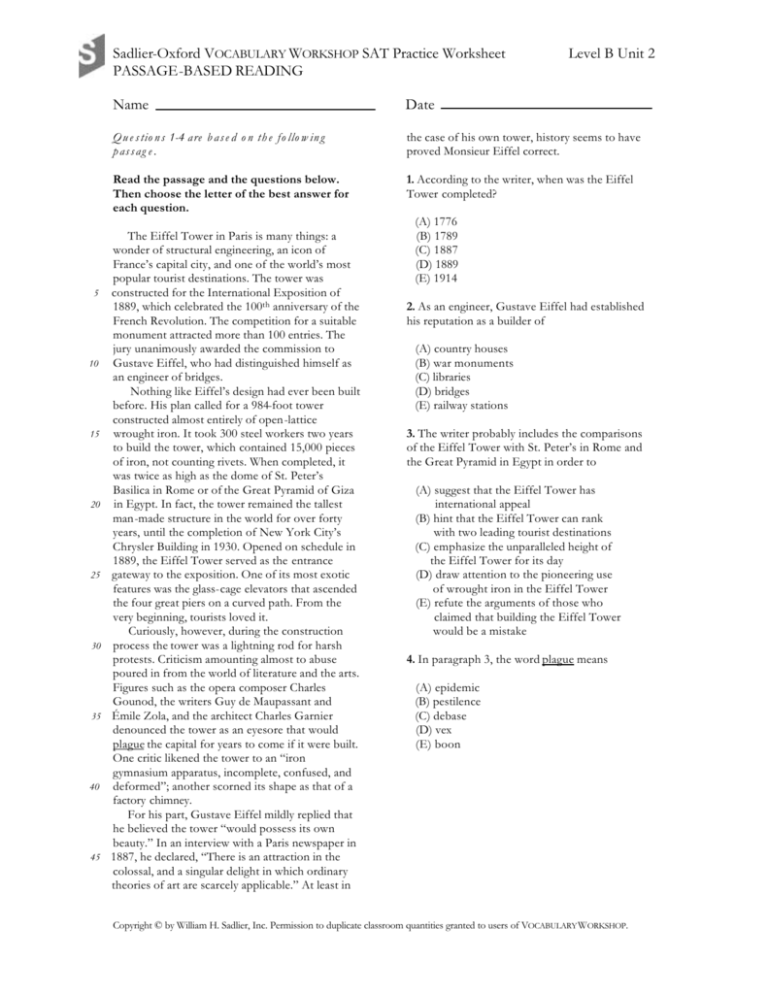
Sadlier-Oxford VOCABULARY WORKSHOP SAT Practice Worksheet PASSAGE-BASED READING 5 10 15 20 25 30 35 40 45 Level B Unit 2 Name Date Questions 1-4 are based on the following passage. the case of his own tower, history seems to have proved Monsieur Eiffel correct. Read the passage and the questions below. Then choose the letter of the best answer for each question. 1. According to the writer, when was the Eiffel Tower completed? The Eiffel Tower in Paris is many things: a wonder of structural engineering, an icon of France’s capital city, and one of the world’s most popular tourist destinations. The tower was constructed for the International Exposition of 1889, which celebrated the 100th anniversary of the French Revolution. The competition for a suitable monument attracted more than 100 entries. The jury unanimously awarded the commission to Gustave Eiffel, who had distinguished himself as an engineer of bridges. Nothing like Eiffel’s design had ever been built before. His plan called for a 984-foot tower constructed almost entirely of open-lattice wrought iron. It took 300 steel workers two years to build the tower, which contained 15,000 pieces of iron, not counting rivets. When completed, it was twice as high as the dome of St. Peter’s Basilica in Rome or of the Great Pyramid of Giza in Egypt. In fact, the tower remained the tallest man-made structure in the world for over forty years, until the completion of New York City’s Chrysler Building in 1930. Opened on schedule in 1889, the Eiffel Tower served as the entrance gateway to the exposition. One of its most exotic features was the glass-cage elevators that ascended the four great piers on a curved path. From the very beginning, tourists loved it. Curiously, however, during the construction process the tower was a lightning rod for harsh protests. Criticism amounting almost to abuse poured in from the world of literature and the arts. Figures such as the opera composer Charles Gounod, the writers Guy de Maupassant and Émile Zola, and the architect Charles Garnier denounced the tower as an eyesore that would plague the capital for years to come if it were built. One critic likened the tower to an “iron gymnasium apparatus, incomplete, confused, and deformed”; another scorned its shape as that of a factory chimney. For his part, Gustave Eiffel mildly replied that he believed the tower “would possess its own beauty.” In an interview with a Paris newspaper in 1887, he declared, “There is an attraction in the colossal, and a singular delight in which ordinary theories of art are scarcely applicable.” At least in (A) 1776 (B) 1789 (C) 1887 (D) 1889 (E) 1914 2. As an engineer, Gustave Eiffel had established his reputation as a builder of (A) country houses (B) war monuments (C) libraries (D) bridges (E) railway stations 3. The writer probably includes the comparisons of the Eiffel Tower with St. Peter’s in Rome and the Great Pyramid in Egypt in order to (A) suggest that the Eiffel Tower has international appeal (B) hint that the Eiffel Tower can rank with two leading tourist destinations (C) emphasize the unparalleled height of the Eiffel Tower for its day (D) draw attention to the pioneering use of wrought iron in the Eiffel Tower (E) refute the arguments of those who claimed that building the Eiffel Tower would be a mistake 4. In paragraph 3, the word plague means (A) epidemic (B) pestilence (C) debase (D) vex (E) boon Copyright © by William H. Sadlier, Inc. Permission to duplicate classroom quantities granted to users of VOCABULARY WORKSHOP.
